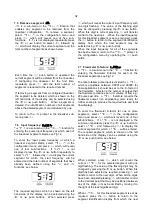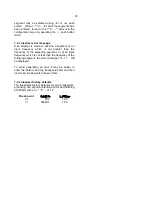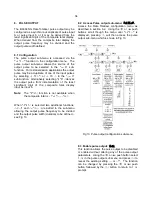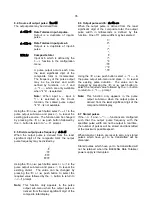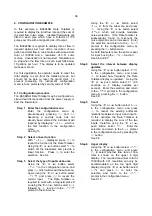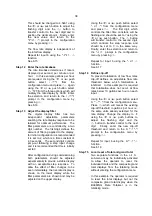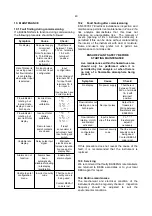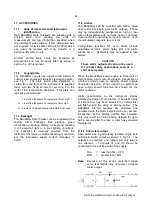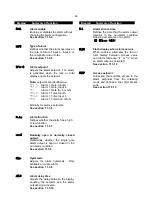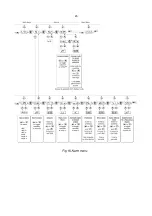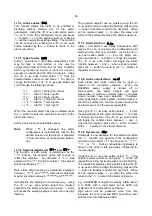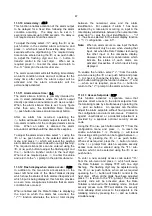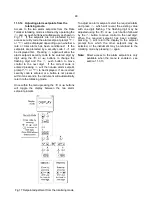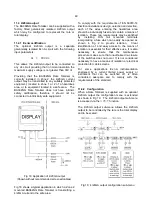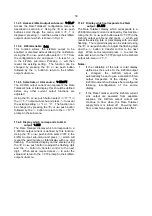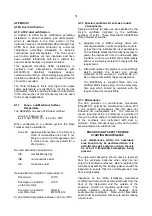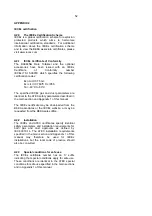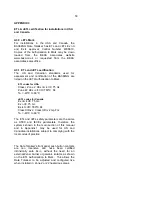
46
11.3.4 Alarm enable:
EnbL
This function allows the alarm to be enabled or
disabled without altering any of the alarm
parameters. Using the
&
or
*
push button select
AL1
or
AL2
from the configuration menu and press
(
to reach
EnbL
in the alarm sub-menu. Pressing
(
will then reveal the existing setting. The function
can be changed by pressing the
&
or
*
push
button followed by the
)
button to return to the
alarm sub-menu.
11.3.5 Type of alarm:
tYPE
Alarm 1 and Alarm 2 are totally independent, both
may be rate or total alarms, or one may be
configured for rate and the other for total. Similarly
both may function on input-A or Input-b or one may
operate on input-A and the other on input-b. Using
the
&
or
*
push button select
tYPE
from the
selected alarm sub-menu and press
(
to check or
change the function. The
&
or
*
push button will
scroll through the following options:
rate
Alarm 1, Rate (A+b or A-b)
rate-a
Alarm 1, Rate, input A
rate-b
Alarm 1, Rate, input b
total
Alarm 1, Total (A+b or A-b)
total-a
Alarm 1, Total, Input A
total-b
Alarm 1, Total, input b
When the required alarm has been selected press
the
)
button to enter the selection and return to the
alarm sub-menu.
Alarm 2 has the same selectable options.
Note:
When
tYPE
is changed, the alarm
configuration is automatically reset to the
default values and the alarm is disabled.
It must therefore be reconfigured before
use.
11.3.6 Setpoint adjustment:
5P1
x
-
and
5P2
x
-
The function of each alarm is determined by the
tYPE
function, the setpoint name will change to
reflect this selection. For example, if
rAtE-b
was
selected in the
tYPE
function for alarm 1, the setpoint
will be identified as
5P1r-b
.
Rate alarm setpoints may be positioned anywhere
between
-99999
and
999999
; total alarm setpoints
may be anywhere between
-9999999
and
99999999
.
All setpoints are adjusted in the same way. Using
the
&
or
*
push button select the required
setpoint in the alarm sub-menu and press
(
which
will reveal the existing setpoint value with one digit
flashing.
The required setpoint can be entered using the
&
or
*
push button to adjust the flashing digit and the
(
button to transfer control to the next digit. When
set as required press
)
to enter the value and
return to the setpoint prompt in the alarm sub-menu.
11.3.7 Alarm function:
Hi. Lo
Alarm 1 and Alarm 2 are totally independent, both
may be Hi or Lo, or one may be conditioned as a Hi
alarm and the other as a Lo alarm. Using the
&
or
*
push button select
Hi.
Lo
from the alarm sub-
menu and press
(
to check or change the function.
The
&
or
*
push button will toggle the alarm
function between
Hi
and
Lo
, when set as required,
press the
)
button to return to the
Hi.Lo
prompt in
the alarm sub-menu.
11.3.8 Alarm output status:
no
.
nC
Each single pole alarm output may be open or
closed in the non-alarm condition. When the
BA384NG power supply is turned off or
disconnected, the alarm outputs will open
irrespective of whether normally open or normally
closed outputs have been selected. Therefore,
when designing an alarm system normally closed
nc
should be selected so that the output opens when
an alarm occurs or if the power supply fails.
Using the
&
or
*
push button select
no
.
nC
from
the selected alarm sub-menu and press
(
to check
or change the function. The
&
or
*
push button
will toggle the contact status between
no
and
nC
,
when set as required, press the
)
button to return
to the
no,nC
prompt in the alarm sub-menu.
11.3.9 Hysteresis:
H5tr
Hysteresis is only available for rate alarms therefore
the
H5tr
function only appears in the configuration
sub-menu when alarm
tYPE
has been set to
rAtE-A
,
rAtE-b
or
rAtE
. During configuration hysteresis is
shown in the units of rate previously configured for
the rate display.
Using the
&
or
*
push button select
H5tr
in the
selected alarm sub-menu and press
(
which will
reveal the existing hysteresis with one digit flashing.
The required hysteresis can be entered using the
&
or
*
push button to adjust the flashing digit and the
(
button to transfer control to the next digit. When
set as required press
)
to enter the value and
return to the
H5tr
prompt in the alarm sub-menu.
e.g. A BA384NG configured to display a flow rate of
0 to 5000, with a high alarm set at 4000 and
hysteresis of 100 will perform as follows:
High alarm will be activated when flow rate
increases to equal or exceed 4000, but will not reset
until the flow rate falls below 3900.

